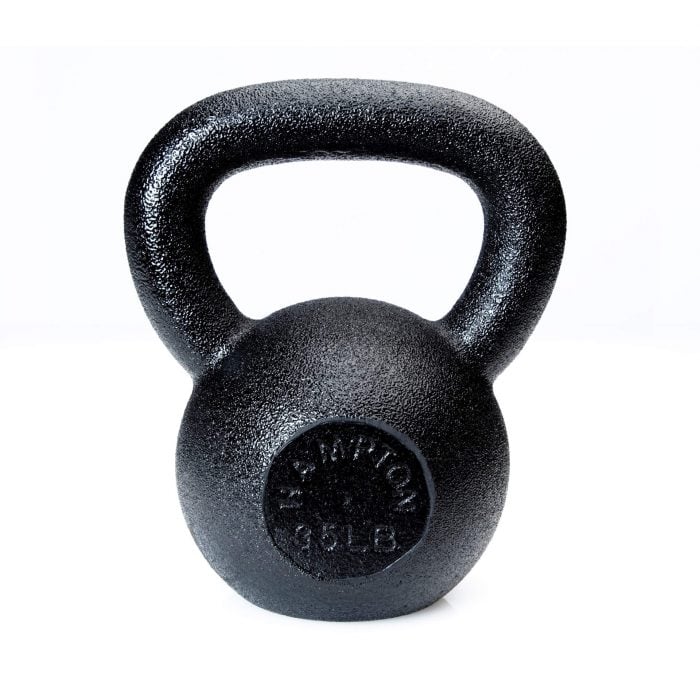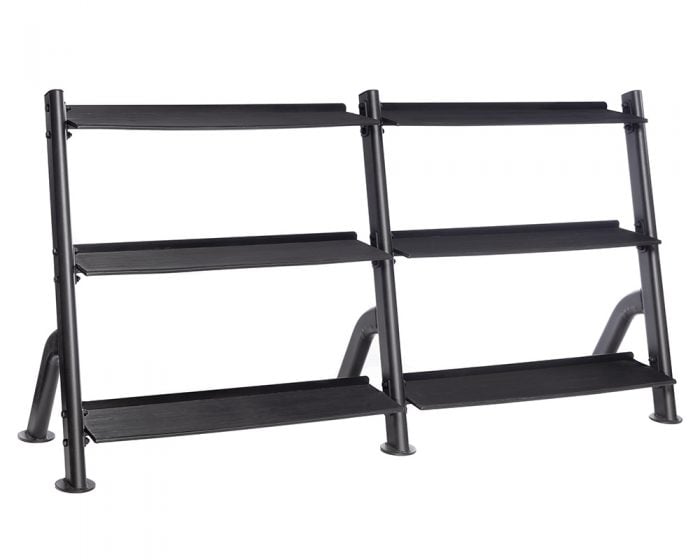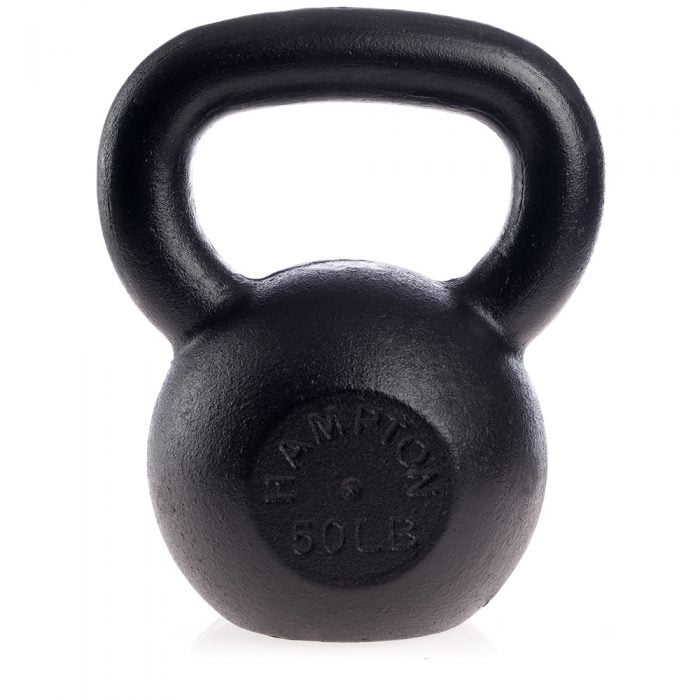One of the most important decisions you’ll make when beginning your kettlebell journey is what size to buy. With so many choices available, the task can feel daunting! We’re here to help you make an informed choice with our guide to kettlebell sizes.
Key Takeaways
- The right kettlebell differs for each man and woman; however, general guidelines are based on your fitness levels and goals.
- Be sure to factor in practical considerations, like space constraints, when choosing the size of your kettlebell.
- Hampton Fitness offers a wide variety of kettlebells to fit every need!
Choosing the Right Kettlebell
When you’re on the path to starting your fitness journey with kettlebells, choosing the right kettlebell size can make the difference between top-notch workouts and burnout. Different kettlebell sizes offer varying resistance levels, making some better suited for beginners than others. For those at the starting stages, a ‘beginner kettlebell’ typically refers to kettlebells that aren’t too heavy to manage but still provide enough weight to help build strength.
Most trainers will tell you that the best starting kettlebell size for men and women differs. Generally, women should start with a kettlebell weighing around 8 kg to 12 kg, while men might find a 12 kg to 16 kg kettlebell more suitable.
Remember, the right kettlebell size isn’t just about what you start with; it’s about what will help you safely and effectively reach your fitness goals. Making an informed choice will help you avoid injury and maximize the effectiveness of your workout. Utilize this guide as you prepare to explore more about kettlebell weight guidelines and practical considerations in your journey. As always, prioritizing safety and proper technique will enhance your training experience and help you reach optimal results.
Determining the Best Kettlebell Starter Weight for Beginners
Determining what size to start with can seem daunting when you’re just starting out with kettlebells. Choosing an appropriate starting kettlebell weight is especially important as a beginner–it will help you avoid injury and maximize effectiveness. Generally, the best kettlebell for beginners should be light enough to handle fundamental movements but heavy enough to provide a challenge. For those wondering about the best starting point, beginners should typically opt for a lighter weight as they master the technique.
When choosing the right beginner’s kettlebell, you should also consider handle diameter and the overall build of the kettlebell to ensure a secure grip and effective workout. Fortunately, beginner-specific models are often designed with newer users in mind, featuring wider handles that accommodate a two-handed grip if needed. This makes it easier for those just starting to learn the correct technique without the added difficulty of managing an awkward grip. Furthermore, selecting a kettlebell with a flat bottom ensures stability when performing exercises like kettlebell swings, rows, or squats, which are staple moves for beginners.
The ideal starting kettlebell weight varies by individual fitness level and goals. A common recommendation is an 8 kg kettlebell for women and a 16 kg kettlebell for men, but these are not one-size-fits-all solutions. For example, if you’re transitioning from other types of weight training, you can start with a slightly heavier kettlebell, ensuring it’s manageable and doesn’t compromise your form.
Ultimately, the best kettlebell for beginners suits their current strength and fitness goals while allowing room for progression. Never compromise safety and technique, so if you’re in doubt, start at a lower weight and check with a fitness trainer.
Kettlebell Weight Guidelines
When it comes to choosing your first kettlebells, weight matters! The right kettlebell weight helps you build proper form and avoid injuries. If you’re a beginner, starting with a weight that isn’t too challenging is especially important. An overly heavy weight can cause muscle injuries, fatigue, and burnout! On the flip side, however, you’ll want to choose a kettlebell that challenges you, helping to grow muscles and increase endurance.
Generally, the weight of the kettlebell you start with varies based on fitness level, gender, and overall strength. Due to natural differences in upper body strength, men typically begin with kettlebells that are heavier than those for women.
If you’ve previously done strength training, you might opt for a slightly heavier kettlebell weight. Selecting a kettlebell weight that challenges you without compromising your form is essential. To achieve optimal results and effective training, incorporate various weight kettlebells into your regimen as you progress. This strategy allows you to gradually increase the weight, continuously challenging your muscles.
We also suggest you assess your fitness goals when choosing the right kettlebell weight. Whether you’re looking to improve endurance, strength, or both, understanding the impact of the kettlebell weight on your training outcomes is essential.
Recommended products
-
Hampton Outdoor Kettlebell – Urethane Coated
$52.00 – $286.00 -
3-Tier Horizontal Kettlebell Rack | 15-PCS.
$999.00 -
Hampton Kettlebell – Black Powder Coated
$14.00 – $270.00
Guidelines for Men
Several factors must be considered when deciding what size kettlebell men should start with. Typically, most men should start kettlebell training with a weight that challenges yet allows for proper form and safety. A standard recommendation for those just getting started is to begin with either a 16kg or a 20kg kettlebell. These sizes balance weight and manageability, allowing you to focus on technique before progressing to heavier weights.
Varying fitness levels do come into play when choosing a size. If you’re a man with strength training experience, you might start with a 20kg kettlebell, whereas a complete beginner might find starting with a lighter option, like 12kg, more suitable. The size you choose must allow you to perform exercises with the correct form to prevent injuries. If you’re unsure, try a few basic exercises with each size kettlebell, asking a friend or trainer to watch your form.
As you progress in your kettlebell training journey, increasing the weight of the kettlebells you use is inevitable. Don’t hesitate to shift to heavier kettlebells as your strength improves! Just ensure that you still use the correct form and technique as you move up.
In conclusion, men should start with a kettlebell weight that matches their current fitness abilities but also challenges them enough to see progression. By carefully selecting the right starting point, you build a solid foundation for more advanced kettlebell exercises, further boosting your strength and endurance.
Guidelines for Women
When considering what size kettlebell you should start with, women must select manageable weights that provide effective resistance for various exercises.
The guidelines for women suggest beginning with a kettlebell weighing around 8 kg (17 lbs) to 12 kg (26 lbs), which provides a balanced challenge for those new to kettlebell training. This size range ensures that you can focus on learning proper form with a weight that isn’t excessively heavy but still challenging enough to engage key muscle groups effectively. To ensure your kettlebell fits your needs, it’s essential to consider the weight and how you start with kettlebell training, incorporating exercises that suit your capabilities and gradually increasing intensity.
As you advance, progressively increase your kettlebell weight to challenge your body and prevent plateaus. Remember, the best kettlebell isn’t just about the weight; it’s about a combination of the correct size that complements your physical conditioning and the types of workouts you plan to perform. Before progressing, ensure you’re comfortable with your current kettlebell; it should feel like a natural extension of your workout regimen, giving you confidence and control during each session.
In summary, determining what size kettlebell women should start with the recommended sizes can be a reliable foundation, enabling a safe and effective start to kettlebell training. Always consider your strength and ability when choosing the best kettlebell, and consult a professional if you’re unsure about the correct sizes for your needs.
Practical Considerations to Start With
When diving into kettlebell training, it’s crucial to understand the practical considerations that can enhance your progress or hold you back. Selecting the right kettlebell isn’t just about the weight; factors such as your fitness level, goals, and even physical space play significant roles. For both men and women, kettlebell training begins with choosing a kettlebell that is manageable for your current ability. While the previous sections discussed various guidelines on starter weights, this section delves deeper into the practicalities of incorporating kettlebell training into your routine.
Firstly, consider the space where you’ll train. A bulky kettlebell might not be the best choice if you’re working out in a tight area. Kettlebell training requires room for swinging and dynamic movements, so space efficiency is critical. The size and weight of your kettlebell should allow you to perform movements freely without restriction. Additionally, don’t overlook the weight progression. It’s tempting to start heavy to see rapid gains, but a too-heavy kettlebell can lead to poor form and potential injuries. Begin with a kettlebell you can lift without compromising your technique, and gradually increase the weight as your strength improves.
Moreover, consider the kettlebell’s material and handle. Comfort in grip and the material’s durability can affect your training efficiency and satisfaction. As highlighted previously, starting with a medium-weight kettlebell for women and a slightly heavier one for men often proves effective. However, every individual’s strength and capability are unique, and it’s essential to adjust based on personal comfort and the specific workouts planned.
Handle Diameter and Kettlebell Types
The handle diameter of a kettlebell directly affects grip comfort and control, which are essential for safe and effective training. Typically, standard kettlebell sizes have a handle diameter ranging from 33mm for smaller sizes to 38mm for larger sizes. It’s vital that you select a kettlebell with a handle that won’t be too thick to hold securely, especially when sweating, or so thin that it feels unstable.
Different types of kettlebells, such as cast iron, competition, or adjustable kettlebells, can influence your decision on what size to select. Cast iron kettlebells are the most common and are known for their wide range in size, shape, and weight. They’re great for general training. On the other hand, competition kettlebells have a uniform handle diameter, regardless of weight, making them ideal for those focused on competitive lifting, as they allow for consistent technique as you progress in size.
Safety and Technique in Kettlebell Training
When engaging in kettlebell exercises, it’s crucial that you prioritize proper form to prevent injuries and maximize the effectiveness of your strength training. Whether you’re swinging a weighted kettlebell or performing other dynamic movements, understanding the fundamental techniques is essential.
Maintain a neutral spine position throughout your workout. Imagine your spine as a straight line, not rounded or arched. Engage your core muscles to support your back and prevent strain. This will help transfer force efficiently during movements. Before each rep, visualize a clear path for the kettlebell’s movement. Ensure there are no obstacles or people in the way to avoid accidental bumps or injuries. Remember, kettlebells swing – maintain a safe distance from others when exercising.
Your body is your best guide. Muscle fatigue is a normal response to exercise, but sharp pain is a red flag. Stop the exercise immediately and consult a doctor if pain persists. Don’t be afraid to take rest days – proper recovery is crucial for progress.
Finally, consider investing in a few sessions with a certified kettlebell trainer. They can assess your form, identify potential issues, and provide personalized guidance to ensure you’re on the right track. If a trainer isn’t an option, utilize high-quality instructional videos to learn proper technique before attempting complex exercises.
Additional Tips to Get Started
As we continue to explore the intricacies of selecting the right kettlebell, here are some additional training tips that will benefit both men and women.
Choosing Kettlebells Based on Goals
Selecting the right starting kettlebell isn’t only about lifting the heaviest weights you can manage – it’s about tapping into what will best support your journey towards healthier strength levels. A moderate weight might serve you best if your aim is general fitness. For those with goals anchored in building significant strength or participating in kettlebell sports, the best starting weights might skew heavier. Below are some guidelines for choosing a kettlebell based on specific goals:
- Muscle Building: If your primary goal is building muscle mass, choose a weight that challenges you towards the latter reps of your sets (around 8-12 repetitions). As you progress, you might need to invest in two kettlebells of different weights.
- Weight Loss/Cardio: To lose weight and improve cardiovascular health, focus on lighter weights (towards the beginning of the weight recommendations for your fitness level) and higher repetitions (15-20 reps per set). You can also increase the intensity by incorporating faster movements or shorter rest periods.
- Overall Fitness: If you have a mix of goals, you can choose a weight that allows you to perform exercises with good form in the 12-15 rep range. This will help build strength and endurance while also burning calories.
Remember, these are general guidelines. It’s always best to listen to your body and adjust the weight as needed. Don’t be afraid to start lighter and gradually progress to heavier weights as you get stronger.
Summary: Choosing the Perfect Size Kettlebell
Deciding what size kettlebell you should start with can be pivotal in creating an effective and safe fitness routine. For those new to this versatile equipment, beginning with the right weight is crucial to prevent injuries and ensure significant progress. Typically, the recommended starting weight varies by fitness level and gender. Men often find that a good starting kettlebell should weigh between 16 and 24 kilograms, especially for those familiar with weight lifting. On the other hand, women typically find that they should begin with kettlebells in a lighter range of 8 to 16 kilograms, depending on their existing strength and experience with resistance training.
Understanding what size kettlebell you should begin with involves recognizing the best sizes that allow for a blend of control and enough challenge to push forward in your stamina and strength training. Recommended weights are guidelines, but personal comfort and safely handling the kettlebell should always be your primary concern. The kettlebell should perfectly fit in your hand and should not be too easy to swing, ensuring both safety and effectiveness.
Whether you’re starting with kettlebells for general fitness or aiming for specific goals like improving endurance or muscle tone, choosing the best weight that matches your current fitness level is essential. Small incremental increases are best for beginners as they provide the safest progression route. Always prioritize technique over heavier weights to maximize benefits and minimize the risk of injury.
Are you looking for the perfect kettlebell? Hampton Fitness offers a wide selection of kettlebells featuring different sizes and grip styles. You’re sure to find your ideal match!





